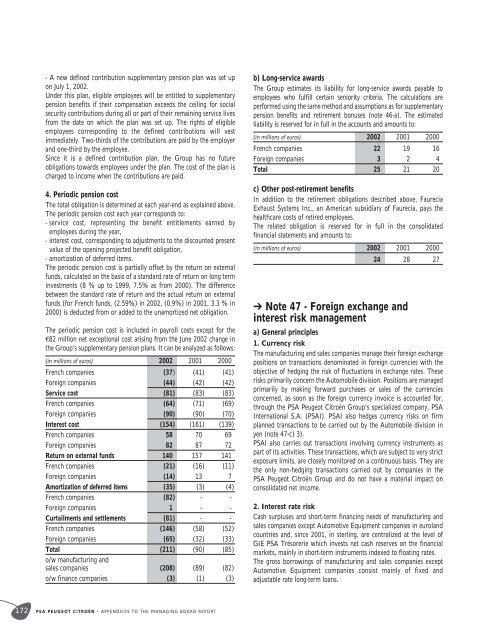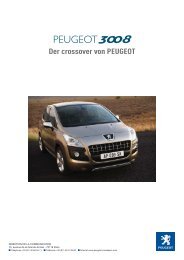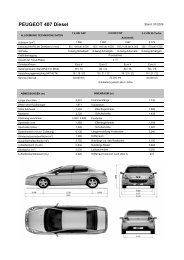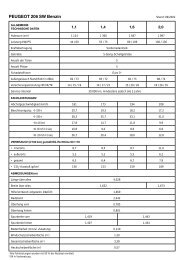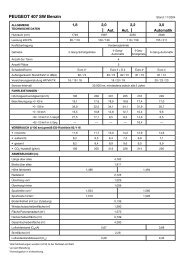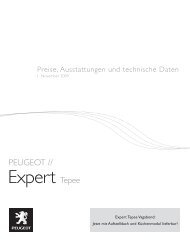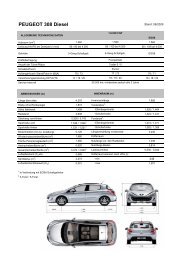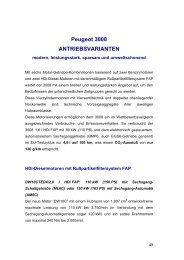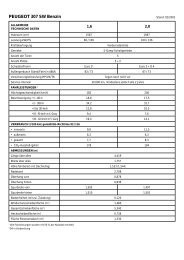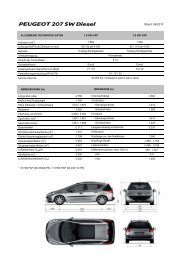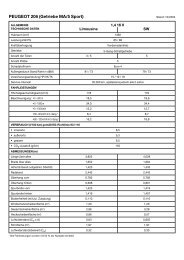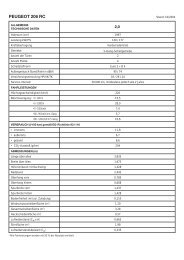PSA COUV page . page RA GB - PEUGEOT Presse
PSA COUV page . page RA GB - PEUGEOT Presse
PSA COUV page . page RA GB - PEUGEOT Presse
You also want an ePaper? Increase the reach of your titles
YUMPU automatically turns print PDFs into web optimized ePapers that Google loves.
- A new defined contribution supplementary pension plan was set up<br />
on July 1, 2002.<br />
Under this plan, eligible employees will be entitled to supplementary<br />
pension benefits if their compensation exceeds the ceiling for social<br />
security contributions during all or part of their remaining service lives<br />
from the date on which the plan was set up. The rights of eligible<br />
employees corresponding to the defined contributions will vest<br />
immediately. Two-thirds of the contributions are paid by the employer<br />
and one-third by the employee.<br />
Since it is a defined contribution plan, the Group has no future<br />
obligations towards employees under the plan. The cost of the plan is<br />
charged to income when the contributions are paid.<br />
4. Periodic pension cost<br />
The total obligation is determined at each year-end as explained above.<br />
The periodic pension cost each year corresponds to:<br />
- service cost, representing the benefit entitlements earned by<br />
employees during the year,<br />
- interest cost, corresponding to adjustments to the discounted present<br />
value of the opening projected benefit obligation,<br />
- amortization of deferred items.<br />
The periodic pension cost is partially offset by the return on external<br />
funds, calculated on the basis of a standard rate of return on long term<br />
investments (8 % up to 1999, 7.5% as from 2000). The difference<br />
between the standard rate of return and the actual return on external<br />
funds (for French funds, (2.59%) in 2002, (0.9%) in 2001, 3.3 % in<br />
2000) is deducted from or added to the unamortized net obligation.<br />
The periodic pension cost is included in payroll costs except for the<br />
€82 million net exceptional cost arising from the June 2002 change in<br />
the Group’s supplementary pension plans. It can be analyzed as follows:<br />
(in millions of euros) 2002 2001 2000<br />
French companies (37) (41) (41)<br />
Foreign companies (44) (42) (42)<br />
Service cost (81) (83) (83)<br />
French companies (64) (71) (69)<br />
Foreign companies (90) (90) (70)<br />
Interest cost (154) (161) (139)<br />
French companies 58 70 69<br />
Foreign companies 82 87 72<br />
Return on external funds 140 157 141<br />
French companies (21) (16) (11)<br />
Foreign companies (14) 13 7<br />
Amortization of deferred items (35) (3) (4)<br />
French companies (82) - -<br />
Foreign companies 1 - -<br />
Curtailments and settlements (81) - -<br />
French companies (146) (58) (52)<br />
Foreign companies (65) (32) (33)<br />
Total (211) (90) (85)<br />
o/w manufacturing and<br />
sales companies (208) (89) (82)<br />
o/w finance companies (3) (1) (3)<br />
b) Long-service awards<br />
The Group estimates its liability for long-service awards payable to<br />
employees who fulfill certain seniority criteria. The calculations are<br />
performed using the same method and assumptions as for supplementary<br />
pension benefits and retirement bonuses (note 46-a). The estimated<br />
liability is reserved for in full in the accounts and amounts to:<br />
(in millions of euros) 2002 2001 2000<br />
French companies 22 19 16<br />
Foreign companies 3 2 4<br />
Total 25 21 20<br />
c) Other post-retirement benefits<br />
In addition to the retirement obligations described above, Faurecia<br />
Exhaust Systems Inc., an American subsidiary of Faurecia, pays the<br />
healthcare costs of retired employees.<br />
The related obligation is reserved for in full in the consolidated<br />
financial statements and amounts to:<br />
(in millions of euros) 2002 2001 2000<br />
24 28 27<br />
➔ Note 47 - Foreign exchange and<br />
interest risk management<br />
a) General principles<br />
1. Currency risk<br />
The manufacturing and sales companies manage their foreign exchange<br />
positions on transactions denominated in foreign currencies with the<br />
objective of hedging the risk of fluctuations in exchange rates. These<br />
risks primarily concern the Automobile division. Positions are managed<br />
primarily by making forward purchases or sales of the currencies<br />
concerned, as soon as the foreign currency invoice is accounted for,<br />
through the <strong>PSA</strong> Peugeot Citroën Group's specialized company, <strong>PSA</strong><br />
International S.A. (<strong>PSA</strong>I). <strong>PSA</strong>I also hedges currency risks on firm<br />
planned transactions to be carried out by the Automobile division in<br />
yen (note 47-c) 3).<br />
<strong>PSA</strong>I also carries out transactions involving currency instruments as<br />
part of its activities. These transactions, which are subject to very strict<br />
exposure limits, are closely monitored on a continuous basis. They are<br />
the only non-hedging transactions carried out by companies in the<br />
<strong>PSA</strong> Peugeot Citroën Group and do not have a material impact on<br />
consolidated net income.<br />
2. Interest rate risk<br />
Cash surpluses and short-term financing needs of manufacturing and<br />
sales companies except Automotive Equipment companies in euroland<br />
countries and, since 2001, in sterling, are centralized at the level of<br />
GIE <strong>PSA</strong> Trésorerie which invests net cash reserves on the financial<br />
markets, mainly in short-term instruments indexed to floating rates.<br />
The gross borrowings of manufacturing and sales companies except<br />
Automotive Equipment companies consist mainly of fixed and<br />
adjustable rate long-term loans.<br />
172<br />
<strong>PSA</strong> <strong>PEUGEOT</strong> CITROËN - APPENDICES TO THE MANAGING BOARD REPORT


